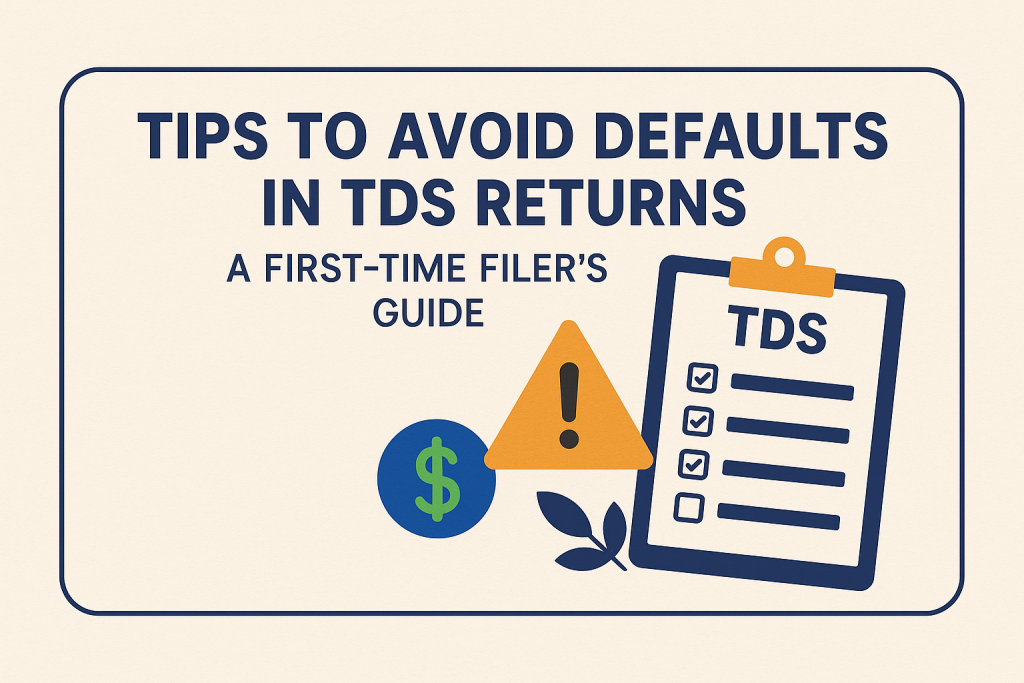Tips to Avoid Defaults in TDS Returns: A First-Time Filer’s Guide
Introduction: Why Accuracy in TDS Returns Matters
For finance professionals stepping into the world of tax compliance, the first experience with TDS (Tax Deducted at Source) returns can be intimidating. But accuracy is not just about good practice—errors or defaults can attract penalties, interest, and even disallowance of expenses.
This guide offers practical, proven tips to help you file your first TDS return without any defaults, ensuring smooth compliance and peace of mind.
📌 What Are TDS Defaults?
TDS defaults are discrepancies or errors noticed in your TDS return that lead to:
- Late filing fees (under Section 234E)
- Interest on late deduction or payment (under Section 201)
- Short or non-deduction of tax
- Mismatch of PAN details
- Incorrect challan mapping
✅ 10 Smart Tips to Avoid TDS Defaults
- Deduct TDS on Time
- TDS must be deducted at the time of credit or payment, whichever is earlier.
- Maintain a calendar for due dates, especially for salary, contractor, professional, and rent payments.
- Deposit TDS Before the Deadline
- For non-government deductors, deposit TDS by the 7th of the following month.
- For March deductions, the due date is April 30th.
- Match PAN and TAN Accurately
- Cross-verify the PAN of deductees and your TAN before uploading returns.
- Use the NSDL PAN verification tool to avoid mismatches.
- Use the Correct Challan Details
- Ensure correct entry of:
- Challan number
- BSR code
- Date of deposit
- Challan amount
- Wrong mapping can lead to defaults despite actual payments.
- Ensure correct entry of:
- Avoid Short Deduction of TDS
- Refer to updated TDS rates from the latest Finance Act.
- Always include surcharge and cess where applicable.
- File Quarterly Returns Within Due Dates
- Due dates:
- Q1 (Apr–Jun): July 31
- Q2 (Jul–Sep): Oct 31
- Q3 (Oct–Dec): Jan 31
- Q4 (Jan–Mar): May 31
- Due dates:
- Generate and Verify Form 27A
- Form 27A is a control sheet that accompanies your return.
- Mismatch in control totals can lead to rejection.
- Validate with FVU Utility
- Use the File Validation Utility (FVU) from TIN-NSDL to catch structural and format errors before uploading.
- Download and Check Form 16/16A
- Reconcile TDS returns with the Form 16/16A issued to deductees to ensure accurate credits.
- Track the Traces Portal for Notices
- Regularly check the TRACES portal for:
- Defaults
- Correction requests
- Justification reports
- Regularly check the TRACES portal for:
🚫 Common Mistakes to Avoid
Mistake | Consequence |
Delayed TDS payment | 1.5% interest per month |
Missing PAN of deductee | 20% TDS instead of lower rate |
Wrong section selected | Entire deduction treated as invalid |
Form not filed | ₹200/day late fee under Section 234E |
💡 Pro Tip: Use a TDS Management Tool
Consider investing in a reliable TDS return filing software to automate:
- Challan mapping
- PAN validation
- Interest calculations
- Justification report analysis
This can drastically reduce human error and help scale your compliance process.
Conclusion
Filing TDS returns doesn’t have to be stressful. With the right tools, vigilance, and an understanding of common pitfalls, first-time filers can avoid defaults with ease.
As a finance professional, staying compliant not only keeps you penalty-free but also builds your credibility in the ecosystem.
📥 Download Checklist: “10 Steps to TDS Return Success”
[Click here to download the PDF checklist ➜]
🙋 Need Help?
Contact Us, for any questions or need assistance with your first TDS return?
Disclaimer: This blog is for informational purposes only and should not be considered tax or legal advice. Always consult a certified tax professional.




